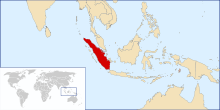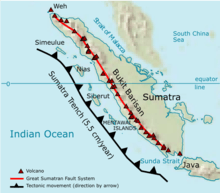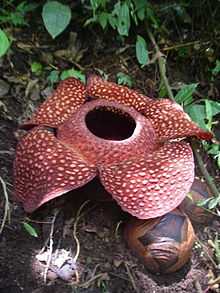Sumatra
 Topography of Sumatra | |
 | |
| Geography | |
|---|---|
| Location | Southeast Asia |
| Coordinates | 00°N 102°E / 0°N 102°ECoordinates: 00°N 102°E / 0°N 102°E |
| Archipelago | Greater Sunda Islands |
| Area | 480,847.74 km2 (185,656.35 sq mi) |
| Area rank | 6th |
| Highest elevation | 3,805 m (12,484 ft) |
| Highest point | Kerinci |
| Country | |
|
Indonesia | |
| Provinces | Aceh, Bengkulu, Jambi, Lampung, Riau, West Sumatra, South Sumatra, North Sumatra |
| Largest settlement | Medan (pop. 2,109,330 (as of 2010)) |
| Demographics | |
| Population | 50,365,538 (as of 2010) |
| Density | 104.74 /km2 (271.28 /sq mi) |
| Ethnic groups | Acehnese, Batak, Minangkabau, Malay, Tionghoa |
Sumatra (Indonesian: Sumatera) is an island in western Indonesia and part of the Sunda Islands. It is the largest island that is entirely in Indonesia (two larger islands, Borneo and New Guinea, are shared between Indonesia and other countries) and the sixth largest island in the world at 480,847.74 km2 (including adjacent islands such as the Riau Islands and Bangga Belitung Islands), with a current population of over 50 million (54 million administratively, as Riau Islands and Bangka–Belitung Islands are included). Its biggest city is Medan which has over 4,300,000 people in its metropolitan area.
Sumatra is an elongated landmass spanning a diagonal northwest-southeast axis. The Indian Ocean borders the west, northwest, and southwest sides of Sumatra with the island chain of Simeulue, Nias and Mentawai bordering the southwestern coast. On the northeast side the narrow Strait of Malacca separates the island from the Malay Peninsula, an extension of the Eurasian continent. On the southeast the narrow Sunda Strait separates Sumatra from Java. The northern tip of Sumatra borders the Andaman Islands, while on the lower eastern side are the islands of Bangka and Belitung, Karimata Strait and the Java Sea. The Bukit Barisan mountains, which contain several active volcanoes, form the backbone of the island, while the northeast sides are outlying lowlands with swamps, mangrove and complex river systems. The equator crosses the island at its center on West Sumatra and Riau provinces. The climate of the island is tropical, hot and humid with lush tropical rain forest once dominating the landscape.
Settler colonies began arriving in Sumatra around 500 BC, and several significant kingdoms flourished there. I Ching, a Chinese Buddhist monk, studied Sanskrit and spent four years of his life working in Palembang. The explorer Marco Polo visited Sumatra in 1292.
Eighty-seven percent of Sumatrans are thought to be Muslim. The island is home to 22% of Indonesia's population.
Sumatra has a huge range of plant and animal species but has lost almost 50% of its tropical rainforest in the last 35 years, and many species are critically endangered such as the Sumatran Ground-cuckoo, Sumatran tiger, Sumatran elephant, Sumatran rhinoceros, and Sumatran orangutan. Deforestation on the island has also resulted in serious haze over neighbouring countries, such as the 2013 Southeast Asian haze causing considerable tensions with affected countries such as Singapore and Malaysia.[1]
Etymology
Sumatra was known in ancient times by the Sanskrit names of Swarnadwīpa ("Island of Gold") and Swarnabhūmi ("Land of Gold"), because of the gold deposits of the island's highland.[2] The first word mentioning the name of Sumatra was the name of Srivijayan Haji (king) Sumatrabhumi ("King of the land of Sumatra"),[3] who sent an envoy to China in 1017. Arab geographers referred to the island as Lamri (Lamuri, Lambri or Ramni) in the tenth through thirteenth centuries, in reference to a kingdom near modern day Banda Aceh which was the first landfall for traders.
Late in the 14th century the name Sumatra became popular in reference to the kingdom of Samudra Pasai, which was a rising power until it was replaced by Sultanate of Aceh. Sultan Alauddin Shah of Aceh, on letters written in 1602 addressed to Queen Elizabeth I of England, referred to himself as "king of Aceh and Samudra".[4] The word itself is from Sanskrit "Samudra", (समुद्र), meaning "gathering together of waters, sea or ocean".[5]
After the introduction of Islam to the archipelago in the 13th century, the island was also called Andalas by Muslim travellers .[6] Sumatra was the farthest east in the Muslim world so its position was in some way similar to Al-Andalus which was the farthest west, hence the name. European writers in the 19th century found that the indigenous inhabitants did not have a name for the island.[7]
History
| Historical population | ||
|---|---|---|
| Year | Pop. | ±% |
| 1971 | 20,808,148 | — |
| 1980 | 28,016,160 | +34.6% |
| 1990 | 36,506,703 | +30.3% |
| 1995 | 40,830,334 | +11.8% |
| 2000 | 42,616,164 | +4.4% |
| 2005 | 45,839,041 | +7.6% |
| 2010 | 50,613,947 | +10.4% |
| sources:[8] | ||
People who spoke Austronesian languages first arrived in Sumatra around 500 BCE. One of the earliest known kingdoms was Kantoli, which flourished in the 5th century CE in southern Sumatra. Kantoli was replaced by the Empire of Srivijaya and then later by the Kingdom of Samudra. Srivijaya was a Buddhist monarchy centred in what is now Palembang. Dominating the region through trade and conquest throughout the 7th to 9th centuries, the empire helped spread the Malay culture throughout Nusantara. The empire was a thalassocracy or maritime power that extended its influence from island to island. Palembang was a center for scholarly learning, and it was there the Chinese Buddhist pilgrim I Ching studied Sanskrit in 671 CE before departing for India. On his journey to China, he spent four years in Palembang translating Buddhist texts and writing two manuscripts.

Srivijayan influence waned in the 11th century after it was defeated by the Chola Empire of southern India. At the same time, Islam made its way to Sumatra through Arabs and Indian traders in the 6th and 7th centuries AD.[9] By the late 13th century, the monarch of the Samudra kingdom had converted to Islam. Marco Polo visited the island in 1292, and Ibn Battuta visited twice during 1345–1346. Samudra was succeeded by the powerful Aceh Sultanate, which survived to the 20th century. With the coming of the Dutch, the many Sumatran princely states gradually fell under their control. Aceh, in the north, was the major obstacle, as the Dutch were involved in the long and costly Aceh War (1873–1903).
Sumatra came under the control of the Dutch East Indies and became a major producer of pepper, rubber, and oil. In the early and mid-twentieth century, Sumatran academics and leaders were important figures in Indonesia's independence movements, such as: Mohammad Hatta (the first vice-president) and Sutan Sjahrir (the first prime minister).
The Great Sumatran fault (a strike-slip fault), and the Sunda megathrust (a subduction zone), run the entire length of the island along its west coast. On 26 December 2004, the western coast and islands of Sumatra, particularly Aceh province, were struck by a tsunami following the Indian Ocean earthquake. More than 170,000 Indonesians were killed, primarily in Aceh. Other recent earthquakes to strike Sumatra include the 2005 Sumatra Earthquake and the October 2010 Sumatra earthquake. Then environment minister Gusti Mohammad Hatta stated in 2010 that Sumatra had experienced tremendous pressures resulting from natural resource exploitation. He further argued that natural forests had decreased, leaving only 29 percent of forest cover on the island.[1]
Administration

The ten administrative Provinces (provinsi) of Sumatra - including the smaller islands nearby - are listed below with their populations at the 2000 and 2010 Censuses,:[10] Note some 4 million of these residents of Sumatra do not live on the island itself—but on nearby islands administered collectively as "Sumatra". The final two of the provinces below do not have territory on the actual island.
| Name | Area (km2) | Population Census 2000 | Population Census 2010 | Population Estimate 2014 | Capital |
|---|---|---|---|---|---|
| Aceh | 157,956.00 | 4,073,006 | 4,486,570 | 4,731,705 | Banda Aceh |
| North Sumatra (Sumatera Utara) | 72,981.23 | 11,642,488 | 12,326,678 | 13,527,937 | Medan |
| West Sumatra (Sumatera Barat) | 42,012.89 | 4,248,515 | 4,845,998 | 5,098,790 | Padang |
| Riau | 87,023.66 | 3,907,763 | 5,543,031 | 6,359,790 | Pekanbaru |
| Jambi | 50,058.16 | 2,407,166 | 3,088,618 | 3,412,459 | Jambi |
| South Sumatra (Sumatera Selatan) | 91,592.43 | 6,210,800 | 7,446,401 | 7,996,535 | Palembang |
| Bengkulu | 19,919.33 | 1,455,500 | 1,713,393 | 1,828,291 | Bengkulu |
| Lampung | 34,623.80 | 6,730,751 | 7,596,115 | 7,972,246 | Bandar Lampung |
| Bangka-Belitung (Kepulauan Bangka Belitung) | 16,424.14 | 899,968 | 1,223,048 | 1,380,762 | Pangkal Pinang |
| Riau Islands (Kepulauan Riau) | 8,256.10 | 1,040,207 | 1,685,698 | 2,031,895 | Tanjung Pinang |
| Totals | 480,847.74 | 42,616,164 | 50,613,947 | 54,339,256 |
Geography

The longest axis of the island runs approximately 1,790 km (1,110 mi) northwest–southeast, crossing the equator near the centre. At its widest point, the island spans 435 km (270 mi). The interior of the island is dominated by two geographical regions: the Barisan Mountains in the west and swampy plains in the east. Sumatra is the closest Indonesian island to mainland Asia.
To the southeast is Java, separated by the Sunda Strait. To the north is the Malay Peninsula (located on the Asian mainland), separated by the Strait of Malacca. To the east is Borneo, across the Karimata Strait. West of the island is the Indian Ocean.
The backbone of the island is the Barisan Mountain chain, with the active volcano Mount Kerinci as the highest point at 3,805 m (12,467 ft), located at about the midpoint of the range. The volcanic activity of this region endowed the region with fertile land and beautiful sceneries, for instance around Lake Toba. It also contains deposits of coal and gold. The volcanic activity stems from Sumatra's location on the Pacific Ring of Fire—which is also the reason why Sumatra has had some of the most powerful earthquakes ever recorded: in 1797, 1833, 1861, 2004, 2005, and 2007.

To the east, big rivers carry silt from the mountains, forming the vast lowland interspersed by swamps. Even if mostly unsuitable for farming, the area is currently of great economic importance for Indonesia. It produces oil from both above and below the soil – palm oil and petroleum.
Sumatra is the largest producer of Indonesian coffee. Small-holders grow Arabica coffee (Coffea arabica) in the highlands, while Robusta (Coffea canephora) is found in the lowlands. Arabica coffee from the regions of Gayo, Lintong and Sidikilang is typically processed using the Giling Basah (wet hulling) technique, which gives it a heavy body and low acidity.[11]
Most of Sumatra used to be covered by tropical rainforest, but economic development coupled with corruption and illegal logging has severely threatened its existence. Even designated conservation areas have not been spared from this destruction.
The island is the world's fifth highest island, and the third highest in the Indonesian archipelago.
Batang Hari River is the longest river in the island with its source in the Minangkabau Highlands, stretching around 800 kilometres eastward to its estuary in the Jambi lowlands.
Largest cities

The largest cities in Sumatra by population, listed by their 2010 census populations,[10] are:
| Rank | Capital City | province | Population 2010 Census |
City Birthday | Area in Km 2 |
|---|---|---|---|---|---|
| 1 | Medan | North Sumatra | 2,109,339 | 1 July 1590 | 265.10 |
| 2 | Palembang | South Sumatra | 1,452,840 | 17 June 683 | 374.03 |
| 3 | Pekanbaru | Riau | 903,902 | 23 June 1784 | 633.01 |
| 4 | Bandar Lampung | Lampung | 879,851 | 17 June 1682 | 118.50 |
| 5 | Padang | West Sumatra | 833,584 | 7 August 1669 | 694.96 |
| 6 | Jambi | Jambi | 529,118 | 17 May 1946 | 205.00 |
| 7 | Bengkulu | Bengkulu | 300,359 | 18 March 1719 | 144.52 |
| 8 | Dumai | Riau | 254,332 | 20 April 1999 | 2,039.35 |
| 9 | Binjai | North Sumatra | 246,010 | 90.24 | |
| 10 | Pematang Siantar | North Sumatra | 234,885 | 24 April 1871 | 60.52 |
| 11 | Banda Aceh | Aceh | 224,209 | 22 April 1205 | 61.36 |
| 12 | Lubuklinggau | South Sumatra | 201,217 | 17 August 2001 | 419.80 |
Flora and fauna
Sumatra supports a wide range of vegetation types which are home to a rich variety of species, including 17 endemic genera of plants.[12] Unique species include the Sumatran Pine which dominates the Sumatran tropical pine forests of the higher mountainsides in the north of the island and rainforest plants such as Rafflesia arnoldii (the world's largest individual flower), and the Titan Arum (the world's largest unbranched inflorescence).
The island is home to 201 mammal species and 580 bird species, such as the Sumatran Ground-Cuckoo. There are 9 endemic mammal species on mainland Sumatra and 14 more endemic to the nearby Mentawai Islands.[12] The species present include: Sumatran Tiger, Sumatran Orangutan, Sumatran Rhinoceros, Sumatran Elephant, Sumatran Striped Rabbit, Dhole, Dayak Fruit Bat, Malayan Tapir, Malayan Sun Bear, Sunda Clouded Leopard, black leopard. There are about 300 freshwater fish species in Sumatra.[13]
The island has lost 48% of its natural forest cover since 1985, and many of the remaining species are endangered. The Sumatran Tiger, Sumatran Rhinoceros, Sumatran Elephant, Sumatran Ground-Cuckoo, and Sumatran Orangutan are all Critically Endangered, indicating the highest level of threat to their survival. In October 2008, the Indonesian government announced a plan to protect Sumatra's remaining forests.[14]
The island includes more than 10 national parks, including 3 which are listed as the Tropical Rainforest Heritage of Sumatra World Heritage Site – Gunung Leuser National Park, Kerinci Seblat National Park and Bukit Barisan Selatan National Park. The Berbak National Park is one of three national parks in Indonesia listed as a wetland of international importance under the Ramsar Convention.
Demographics

Sumatra is not particularly densely populated, with just over 100 people per km2 – more than 50 million people in total. Because of its great extent, it is nonetheless the fourth[15] most populous island in the world. The most populous regions include most of North Sumatra and central highlands in West Sumatra, while the major urban centers are Medan and Palembang.
The people represent many ethnic groups, speaking 52 languages. Most of these groups share many similar traditions, and the different tongues are closely related. Ethnic Malay dominate most of the eastern coast, while people in the southern and central interior speak languages related to Malay, such as the Lampung and Minangkabau people. The highland of northern Sumatra is inhabited by the Bataks, while the northernmost coast is dominated by Acehs. Ethnic Chinese minorities are present in urban centres.
A majority of people in Sumatra are Muslims (87%), while 10% are Christians, 2% are Buddhist and 1% are Hindu.[16] Most central Bataks are Protestant Christians, a religion introduced by the German Rhenish Missionary Society.
Rail transport
Several unconnected railway networks built during Netherlands East Indies exist in Sumatra, such as the ones connecting Banda Aceh-Lhokseumawe-Besitang-Medan-Tebingtinggi-Pematang Siantar-Rantau Prapat in Northern Sumatra (the Banda Aceh-Besitang section was closed in 1971, but is being rebuilt, as of 2011[17]), Padang-Solok-Bukittinggi in West Sumatra, and Bandar Lampung-Palembang-Lahat-Lubuk Linggau in Southern Sumatra.
Plans have been announced (late 2014) for a 2,168 km Trans-Sumatra railway to stretch from Aceh to Lampung.
See also
References
- ↑ http://edition.cnn.com/2013/06/19/world/asia/singapore-haze/?hpt=hp_t3
- ↑ Drakard, Jane (1999). A Kingdom of Words: Language and Power in Sumatra. Oxford University Press. ISBN 983-56-0035-X.
- ↑ Munoz. Early Kingdoms. p. 175.
- ↑ Sneddon, James N. (2003). The Indonesian language: its history and role in modern society. UNSW Press. p. 65. ISBN 9780868405988.
- ↑ Macdonell, Arthur Anthony (1924). A practical Sanskrit dictionary with transliteration, accentuation, and etymological analysis. Motilal Banarsidass Publ. p. 347. ISBN 9788120820005.
- ↑ "Indonesia Islands Map Travel Information". Bestindonesiaislands.com. Retrieved 2012-07-25.
- ↑ Reid, Anthony (2005). An Indonesian Frontier: Acehnese and Other Histories of Sumatra. National University of Singapore Press. ISBN 9971-69-298-8.
- ↑ http://www.bps.go.id/tab_sub/view.php?kat=1&tabel=1&daftar=1&id_subyek=12¬ab=1
- ↑ G.R. Tibbets,Pre-Islamic Arabia and South East Asia, in D.S. Richards (ed.),1970, Islam and The Trade of Asia, Oxford: Bruno Cassirer Pub. Ltd, p. 127 nt. 21; S.Q.Fatimi, In Quest of Kalah, in D.S. Richards (ed.),1970, p.132 n.124; W.P. Groeneveldt, Notes in The Malay Archipelago, in D.S. Richards (ed.),1970, p.129 n.42
- ↑ 10.0 10.1 Biro Pusat Statistik, Jakarta.
- ↑ "Daerah Produsen Kopi Arabika di Indonesia". Kopi Distributor 1995. 2015-02-28. Retrieved 2015-02-28.
- ↑ 12.0 12.1 Whitten, Tony (1999). The Ecology of Sumatra. Tuttle Publishing. ISBN 962-593-074-4.
- ↑ Nguyen, T.T.T., and S. S. De Silva (2006). Freshwater finfish biodiversity and conservation: an asian perspective. Biodiversity & Conservation 15(11): 3543-3568
- ↑ staff (2008-10-14). "Forest, Wildlife Protection Pledged at World Conservation Congress". Ens-newswire.com. Retrieved 2012-07-25.
- ↑ "Population Statistics". GeoHive. Retrieved 2012-07-25.
- ↑ "Number of Population by Religion Year 2005".
- ↑ http://www.thejakartaglobe.com/columnists/the-slow-train/476582
External links
| Wikimedia Commons has media related to Sumatra. |
 Sumatra travel guide from Wikivoyage
Sumatra travel guide from Wikivoyage- William Marsden, The History of Sumatra, (1783); 3rd ed. (1811) on line.
| ||||||||||||||||||||||||||||||

